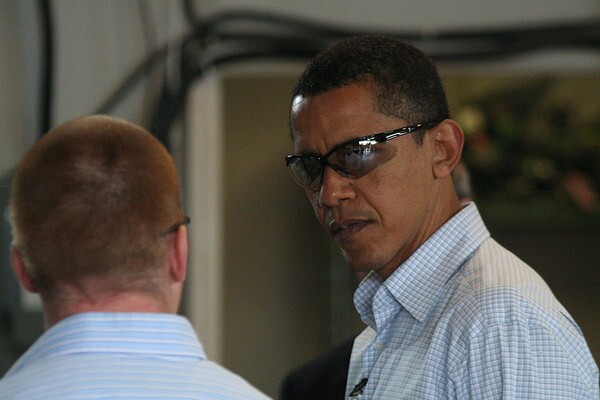M.I.T.: Obama Must Change Course To Fix Climate Crisis

Candidate Obama visiting the PV Power factory in Bend, OR in 2008 | Photo: Barack Obama/Flickr/Creative Commons License
The editors of the MIT Technology Review have a message for President Obama: "You've got four years to set us on track to fix the climate, and your own administration's policy is one of the problems." The editors slam Obama for using renewable energy policy as a short-term job creator rather than working to change the structure of our energy economy, with "hundreds of millions of lives" hanging in the balance.
Obama's emphasis on economic stimulus through renewable energy policy has led to an overemphasis on "quick-fix" shovel-ready projects, say the authors, when deep policy changes and aggressive funding of research and development have been what's really needed to move our country off fossil fuels for good.
The message, in the form of an open letter to the President, appeared last week on the influential technology publication's website.
The authors credit Obama for making some steps in the right direction during his first term, but fault the President for trying to soften the blow of the costs of urgently needed energy reform with happy talk about new jobs:
Slowing down global warming won't be cheap. You have often stressed the economic benefits of choosing new energy technologies. You make a valid argument that moving away from fossil fuels will have positive implications for many businesses. And certainly new technologies will provide jobs and other economic opportunities. But we can no longer pretend that addressing climate change will be without real costs. Economic studies show that it is likely to cost trillions of dollars worldwide, though those analyses also present evidence that the price will grow higher the longer we wait.
They continue in stark terms:
It's time to acknowledge that green jobs were always just political cover for that motive. You must say unambiguously that the real reason to transform our energy system is to avoid the most catastrophic effects of global warming.This is a deeply unpalatable political message. It means immediate spending and economic sacrifice by present-day voters in order to achieve benefits that will be realized decades from now. And it must be done while millions of Americans are still skeptical that global warming is taking place or that it is caused by human activity. But as extensive and exacting analyses over the last decade have shown, we can no longer wait without risking dramatic upheavals in global security and the health and welfare of hundreds of millions of the world's inhabitants.
It's worth noting that much of the current push for utility-scale public lands solar and wind development stems from the Obama administration's emphasis on "shovel-ready" projects. The whole advantage of siting renewable energy development on public lands has been that it can -- at least in theory -- be promoted quickly, without having to deal with private landowners -- often by the hundreds for a large project.
That emphasis may well have slowed California's installation of solar by a significant margin. If the billions of dollars in stimulus funding that have subsidized remote utility-scale projects had been plowed into distributed generation and local utility-scale development instead, California might well have four or five times the solar generating capacity it does now.
Not that changing one's choice of low-hanging fruit is really what the authors of the MIT Technology Review letter have in mind either. Intstead, they advocate for aggressive research funded by a tax on carbon:
Renewable energy sources, like solar and advanced biofuels, are simply not yet ready to compete with fossil fuels. Solar power, for example, still generates less than 1 percent of our nation's electricity and, under most circumstances, remains much more expensive than electricity generated from fossil fuels. We need new and far more advanced technologies. Creating cleaner ways to produce energy will require inventions in physics and chemistry labs and innovations in how we scale up and test those inventions. And it will require market incentives, such as a tax or some other price on carbon dioxide emissions, to encourage consumers and industry to use clean energy. Your administration can play a critical role in each of these areas, from increasing funding for energy R&D to helping establish facilities where companies can share the costs and risks of testing new technologies. Perhaps most important, you will need to rally the nation around the issue of tackling climate change. Only with broad public support can you hope to push a recalcitrant Congress into passing legislation that will establish some form of carbon pricing.
The stake, as the letter points out, are just unacceptably high should we choose any other path:
The International Energy Agency reports that global emissions of carbon dioxide from fossil-fuel combustion reached a record 31.6 metric gigatons in 2011. To have a decent chance of limiting the average global temperature increase to 2 °C and avoiding the most devastating effects of climate change, we will need carbon emissions to peak at no more than 32.6 metric gigatons, and to start falling no later than 2017. The president who takes office that year will thus be facing a far more urgent problem--probably, like you, with no political consensus on how to solve it. But as a president in his final term, you have a chance to take risks. You have the power and the opportunity to lay the groundwork for a new clean-energy policy that will help us avoid the worst consequences of climate change. It is quite possible that if this is not done over the next four years, it will be too late.
ReWire is dedicated to covering renewable energy in California. Keep in touch by liking us on Facebook, and help shape our editorial direction by taking this quick survey here.


